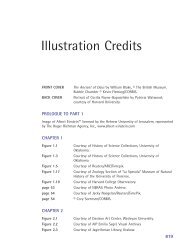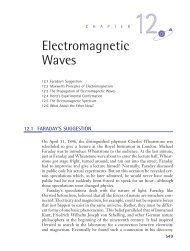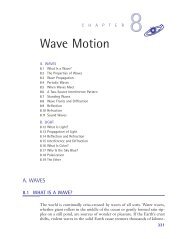Chapter 9: Einstein and Relativity Theory (319 KB) - D Cassidy Books
Chapter 9: Einstein and Relativity Theory (319 KB) - D Cassidy Books
Chapter 9: Einstein and Relativity Theory (319 KB) - D Cassidy Books
You also want an ePaper? Increase the reach of your titles
YUMPU automatically turns print PDFs into web optimized ePapers that Google loves.
3637_<strong>Cassidy</strong>TX_09 6/14/02 12:08 PM Page 421<br />
Jane<br />
9.6 RELATIVITY OF TIME 421<br />
FIGURE 9.10 Laser clock in spaceship (as<br />
seen from an outside observer’s frame of<br />
reference).<br />
D<br />
D<br />
d<br />
v<br />
John<br />
tivity tells her that the clock behaves exactly as it would if she were at rest.<br />
In fact, according this principle, she could not tell from this experiment (or<br />
any other) whether her ship is at rest or moving relative to John, without<br />
looking outside the spaceship. But to John, who is not in her reference<br />
frame but in his own, she appears to him to be moving forward rapidly in<br />
the horizontal direction relative to him. (Of course, it might be John who<br />
is moving backward, while Jane is stationary; but the observation <strong>and</strong> the<br />
argument that follows will be the same.)<br />
Observing Jane’s laser clock as her spaceship flies past him, what does<br />
John see Just as before, in the experiment with the ball observed to be<br />
falling toward the floor when released by a moving person, John sees something<br />
quite different from what Jane sees. Because her spaceship is moving<br />
with respect to him, he observes that the light pulse follows a diagonal path<br />
upward to the upper mirror <strong>and</strong> another diagonal path downward to the<br />
detector. Let us give the symbol t for the time he measures for the round<br />
trip of the light pulse.<br />
Here enters the second postulate: the measured speed of light must be<br />
the same as observed by both John <strong>and</strong> Jane. But the distance the light<br />
pulse travels during one round trip, as Jane sees it, is shorter than what<br />
John sees. Call the total distance the pulse travels from the emitter to the<br />
upper mirror <strong>and</strong> back d for Jane <strong>and</strong> d for John. The speed of light, c,<br />
which is the same for each, is<br />
d<br />
Jane: c ,<br />
t<br />
d<br />
John: c .<br />
t






